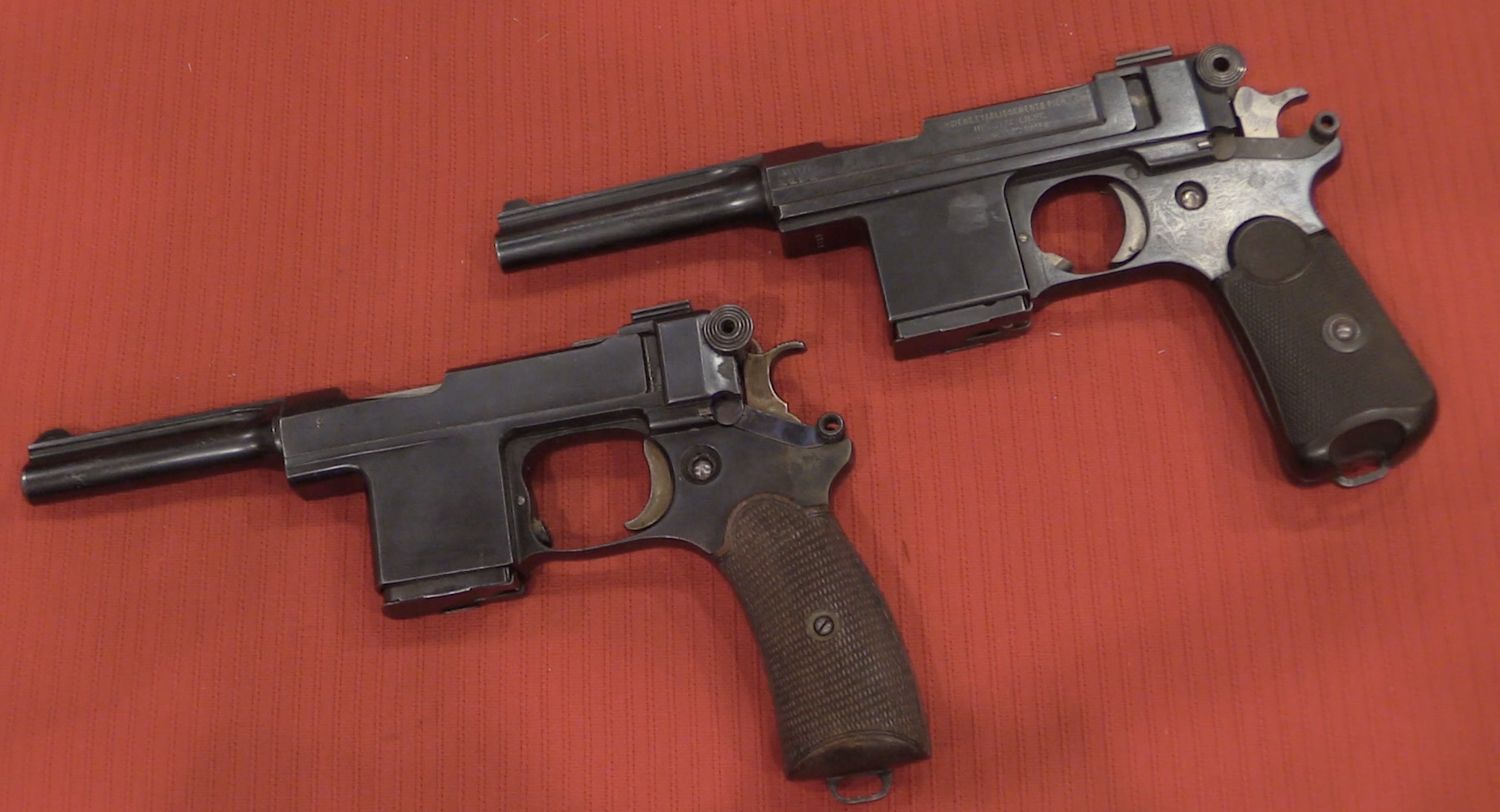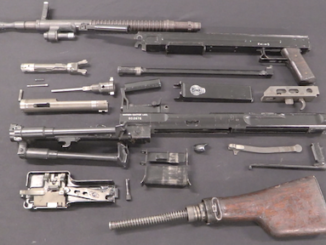First produced in 1902, the Madsen was one of the first practical light machine guns, and it remained in production for nearly 5 decades. The Madsen system is a rather unusual recoil-operated mechanism with a tilting bolt and a remarkably short receiver. The most unusual variation on the system was the belt-fed, high rate-of-fire pattern developed for aircraft use. This program was initiated by the Danish Air Force in the mid 1920s, and several different patterns were built by the time World War Two erupted.
The model here was actually a pattern that was under production for Hungary when German forces occupied Denmark. Taking over the factory, they continued the production and the guns went to the Luftwaffe for airfield defensive use.
In order to use disintegrating links instead of box magazines, some very odd modifications had to be made to the Madsen. One set of feed packs are actually built into the belt bo itself, and the cannot function without the box attached. The only feasible path for empty link ejection is directly upwards, and so a horseshoe-shaped link chute was attached to the top cover, guiding link up over 7th gun and dropping them out the right side of the receiver. Very weird!
While several thousand of these were made under German occupation, very few survive today and they are extremely rare on the US registry.




Steampunk to the max!
Here’s one with a bipod in use with the norwegian Homeguard (HV) in the 1950s:
https://i.ibb.co/5BMwDGx/madsen41mg.jpg
in the early 80’s, I remember a photo in the Palm Beach Post newspaper, showing a couple of El Salvadoran soldiers fielding a Madsen machine gun. It had a curved, top- mounted magazine and the coolest thing was the cocking handle with what looked like a white-porcelain knob attached. looked like museum piece.
ACES&EIGHTS
You can find modern photos of Brazilian SWAT and special police units still running those, the Army apparently bought several batches between 1934 and 1949 and kept them around until 1996, when they were retired from service and turned over to police. Ian made a video on them that’s on Youtube about two weeks ago.
Stupid question: how well would this have fared against a squadron of fully loaded P-47-G’s? I suspect any flak gunner with the Madsen wouldn’t last one minute.
Yes. A stupid question.
any one gunner with any MG would not fare well against a brace of P-47’s. Typical Yank wank fantasy there.
“(…)P-47(…)G(…)”
Keep in mind presented weapon was developed in 1920s, in times when wide usage of metal inside aeroplane designs was highly unusual. If you need to entertain hypothetical usage select aeroplane from same era e.g. Bréguet XIX
“(…)any flak gunner with the Madsen(…)”
Madsen also produced up-scaled version of this gun, which used 23×106 Madsen cartridge https://naboje.org/node/14223 which I presume could do damage to said P-47.
https://www.bevfitchett.us/machine-gun-v1-repeating-weapons/madsen-aircraft-cannon-1.html
Ultimate evolution of the Peabody.
The Madsen is one of those things that just blows your mind that it even works, let alone works well.
I remember the one I handled as being a bit of an awe-inspiring “WTF? This works…?” moment. You look into the guts of the weapon, and trace out the path taken by the cartridge, and you can only marvel at the sheer steampunk complexity of it all. And, might I repeat? It WORKS!
Not that I’d like to be the armorer tasked with caring for the damn things, but… Wow.
And, this one? With the belt-feed? I have always wondered how the hell they pulled that off, and here’s Ian showing us in living color. Many thanks, for that.
It’s still a bit of a mind-screw, realizing that the Lafette tripod came out of DISA, and that it was initially designed for the Madsen. It makes you just wonder, what the hell the company would have done if they’d just started with something a bit more modern in conception than the “automated Martini-Henry” I’ve heard the Madsen LMG described as… Truly an impressive feat of engineering, but… What could all that genius have done, had it started with something a bit more modern in conception, like maybe one of the tilting bolt designs out of Czechoslovakia?
I am still a bit amazed that the Danish Army chose to go with a modernized Madsen LMG for WWII. Other than pride in a native product, wouldn’t it have been better to go with something like the BREN or the Chatellarault? Maybe even a belt-fed? Anything other than what they went to war with… Which was great, for WWI, but by the late 1930s, was already showing signs of outright obsolescence.
@eon: Friend, “still amazed that the Danish Army chose to go with a modernized Madsen LMG for WWII…” Let’s face it: Denmark didn’t have any money to really lavish much on her armed forces in the 1920s. France prioritized: “1) we need a new rifle/LMG cartridge, 2) we need a super-trench in the ouvrages of the Maginot Line, 3) we need the finest two-man tanks ever devised…” Germany prioritized: “1) we need a GPMG, 2) we need a Luftwaffe, 3) we’d better get to work on tanks, but at least we have these here Czechoslovakian guns… Britain prioritized: “1) we need an air force, 2) we need a good LMG [Bren gun] …”
Denmark? Model 1889 Krag-Jorgensen rifle, 1923 steel helmet, same black great coat as the early 20th century… and a Nimbus motorcycle fitted with a Madsen/ DISA 20mm autocannon! Not enough of those, unfortunately.
If you ever get the chance, there is a good Danish WWII film, “April 9th” about the one outfit of bicycle troops that didn’t get his majesty’s memo to surrender to the Germans to avoid needless bloodshed and loss of life… So they fought on until everyone had fired all 40 cartridges in their load out and had to give up “a day late,” much to the distaste and displeasure of the ueber-punctual German invaders.
As LMGs go, the Madsens were picked up by quite a few Latin American nations, who used them well past their “use by” date too.
“(…)bit more modern(…)”
Madsen later produced machine gun, which is less likely to “blows your mind” namely MADSEN-SAETTER sustained fire Machine Gun, Mark 3
https://smallarmsreview.com/madsen-saetter-gpmg/
Mechanically it was similar to Soviet RPD. It was available in different calibers and apparently also in bigger version of 12,7 mm caliber
http://modernfirearms.net/en/machineguns/denmark-machineguns/madsen-saetter-eng/
and found some user, but was bit late to compete with FN MAG.
“(…)had it started with something a bit more modern(…)”
Madsen rekylgevær M. 1903 was spawned by Madsen-Rasmussen M1896 self-loading rifle, see 2nd image from top https://modernfirearms.net/en/military-rifles/self-loading-rifles/denmark-self-loading-rifles/madsen-m1896-eng/
In that time no-one was sure what would be best for crafting self-loading rifle so there were not many ideas proven to work in self-loading rifles which could be stolen at that time.
“(…)wouldn’t it have been better to go with something like the BREN or the Chatellarault(…)”
Denmark at that time used 8×58 rimmed cartridge. BREN also, but they need lot effort to make its’ magazine work reliable. Madsen magazine is also quite peculiar if you look at where normal magazine have exits, so I am not sure if it would be good idea to make new weapon specifically for consuming it.
I have a parts kit for one of these, though my model is slightly different in a few places, since I understand it was for a Portugese armored vehicle contract (armored barrel shroud and different sights). According to an acquaintance who owned a transferrable example, the rate of fire is closer to 2000 rpm, much faster than an MG42. I believe it, since the recoil system is far more robust than on a normal Madsen, and this unique action allows the moving parts to reciprocate less than the length of a cartridge despite never decoupling from the barrel. Also, on my example, most of the cam surfaces that control the various operations have hardened inserts installed, where the original gun would just be a single part; that also implies much more stress on the parts. Hideously expensive, no doubt, and I still can’t believe such a Byzantine design was being marketed, let alone adopted, let alone fielded, in the years after WWII when modern streamlined designs were so available.